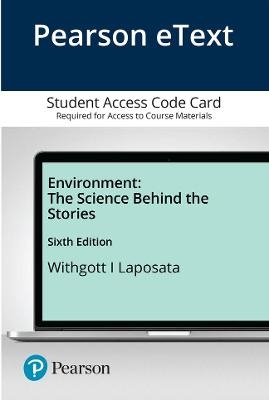
Pearson eText Environment
Pearson (Hersteller)
978-0-13-487363-3 (ISBN)
Pearson eText is an easy-to-use digital textbook that instructors can assign for their course. The mobile app lets you keep on learning, no matter where your day takes you — even when you're offline. You can also add highlights, bookmarks, and notes in your Pearson eText to study how you like.
NOTE: You are purchasing an access card only. Pearson eText is a fully digital delivery of Pearson content. Before purchasing, check with your instructor to confirm the correct ISBN. To register for and use Pearson eText, you may also need a course invite link, which your instructor will provide. Follow the instructions provided on the access card to learn more.
Jay Withgott is the primary author and has been with the book since the first edition. He is a seasoned science writer. Matt Laposata teaches at Kennesaw State University, where over 4000 undergraduates take the Introduction to Environmental Science course each year. Matt brings a fresh, teaching¿-based perspective to the book thanks to his classroom experience. Matt’s research interests are in science education and he has been a part of several NSF-funded projects specifically aimed at improving environmental science education.
1. Science and Sustainability
Our Island, Earth
The Nature of Environmental Science
The Nature of Science
Sustainability and Our Future
2. Earth’s Physical Systems
Matter, Chemistry, and the Environment
Energy: An Introduction
Geology: The Physical Basis for Environmental Science
Geologic and Natural Hazards
3. Evolution, Biodiversity, and Population Ecology
Evolution: The Source of Earth’s Biodiversity
Ecology and the Organism
Population Ecology
Conserving Biodiversity
4. Species Interactions and Community Ecology
Species Interactions
Ecological Communities
Earth’s Biomes
5. Environmental Systems and Ecosystem Ecology
Earth’s Environmental Systems
Ecosystems
Biogeochemical Cycles
6. Ethics, Economics, and Sustainable Development
Culture, Worldview, and the Environment
Environmental Ethics
Economics and the Environment
Sustainable Development
7. Environmental Policy
Environmental Policy: An Overview
U.S. Environmental Law and Policy
International Environmental Policy
Approaches to Environmental Policy
8. Human Population
Our World at Seven Billion
Demography
Population and Society
9. The Underpinnings of Agriculture
The Changing Face of Agriculture
Soil: A Foundation of Agriculture
Water for Agriculture
Nutrients for Plants
Pollination
Conserving Agricultural Resources
10. Making Agriculture Sustainable
The Race to Feed the World
Raising Animals for Food
Preserving Crop Diversity and Pollinators
Controlling Pests and Weeds
Genetically Modified Food
Organic Agriculture
Sustainable Food Production
11. Biodiversity and Conservation Biology
Life’s Diversity on Earth
Benefits of Biodiversity
Biodiversity Loss and Extinction
Conservation Biology: The Search for Solutions
12. Forests, Forest Management, and Protected Areas
Forest Ecosystems and Forest Resources
Forest Loss
Forest Management
Parks and Protected Areas
13. The Urban Environment
Our Urbanizing World
Sprawl
Creating Livable Cities
Urban Sustainability
14. Environmental Health and Toxicology
Environmental Health
Toxic Substances and Their Effects on Organisms
Toxic Substances and Their Effects on Ecosystems
Studying Effects of Hazards
Risk Assessment and Risk Management
Philosophical and Policy Approaches
15. Freshwater Systems and Resources
Freshwater Systems
Solutions to Depletion of Fresh Water
Freshwater Pollution and Its Control
16. Marine and Coastal Systems and Resources
The Oceans
Marine and Coastal Ecosystems
Marine Pollution
Emptying the Oceans
Marine Conservation
17. Atmospheric Science, Air Quality, and Pollution Control
The Atmosphere
Outdoor Air Quality
Ozone Depletion and Recovery
Addressing Acid Deposition
Indoor Air Quality
18. Global Climate Change
Our Dynamic Climate
Studying Climate Change
Current and Future Trends and Impacts
Responding to Climate Change
19. Fossil Fuels
Sources of Energy
Fossil Fuels: Their Formation, Extraction, and Use
Reaching Further for Fossil Fuels
Addressing Impacts of Fossil Fuel Use
Energy Efficiency and Conservation
20. Conventional Energy Alternatives
Alternatives to Fossil Fuels
Nuclear Power
Bioenergy
Hydroelectric Power
21. New Renewable Energy Alternatives
“New” Renewable Energy Sources
Solar Energy
Wind Power
Geothermal Energy
Ocean Energy Sources
Hydrogen and Fuel Cells
22. Managing Our Waste
Approaches to Waste Management
Municipal Solid Waste
Industrial Solid Waste
Hazardous Waste
23. Minerals and Mining
Earth’s Mineral Resources
Mining Methods and Their Impacts
Toward Sustainable Mineral Use
24. Sustainable Solutions
Sustainability on Campus
Strategies for Sustainability
Precious Time
| Erscheint lt. Verlag | 15.9.2020 |
|---|---|
| Sprache | englisch |
| Maße | 216 x 279 mm |
| Gewicht | 43 g |
| Themenwelt | Naturwissenschaften ► Biologie ► Ökologie / Naturschutz |
| Technik ► Umwelttechnik / Biotechnologie | |
| ISBN-10 | 0-13-487363-7 / 0134873637 |
| ISBN-13 | 978-0-13-487363-3 / 9780134873633 |
| Zustand | Neuware |
| Haben Sie eine Frage zum Produkt? |